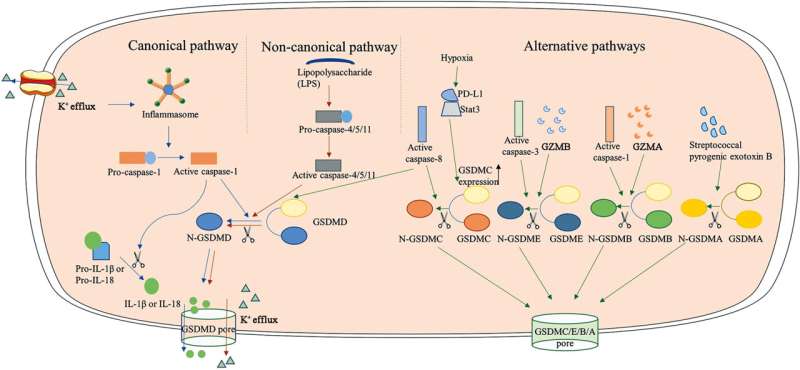This article has been reviewed according to Science X's editorial process and policies. Editors have highlighted the following attributes while ensuring the content's credibility:
fact-checked
proofread
The complex role of pyroptosis in lung cancer

Lung cancer, one of the most aggressive forms of cancer, continues to be a leading cause of death worldwide. Although several new therapies have been developed for this disease, it has a poor prognosis in its advanced stages.
A primary reason underlying this poor response to treatment is the formation of a tumor microenvironment (TME)—the environment that surrounds a tumor and plays a crucial role in its growth. To develop approaches that can overcome treatment resistance during the advanced stages of this cancer, we need to understand how cancer cells evade programmed cell death (PCD) in the TME.
PCD is of many different types, including apoptosis, pyroptosis, necroptosis, and ferroptosis. "Among these, pyroptosis is the most common pro-inflammatory cell death pathway, can elicit the most robust immune response, and is associated with distinct morphological features, such as cell swelling, chromatin condensation, and the loss of cell membrane barrier functions," explains Dr. Wensheng Zhou of the Department of Pulmonary Medicine, Shanghai Chest Hospital, Shanghai Jiao Tong Hospital, China.
Along with his team, Dr. Zhou led a review that explored different pyroptotic cell death pathways and how they can be used against lung cancer cells. This article was published online on April 18, 2023 in Chinese Medical Journal Pulmonary and Critical Care Medicine.
The article discusses two crucial pathways that lead to the activation of pyroptosis—the canonical pathway and the non-canonical pathway, along with other alternative mechanisms. Inflammasomes, caspases, and gasdermin (GSDM) were identified as the key components involved in pyroptosis. Pyroptosis is known to play a key role in both tumorigenesis and anti-tumor defense in lung cancer.
"Pyroptosis components increase the proliferative and migratory abilities of lung cancer cells, but also promote an anti-tumor immune microenvironment," says Dr. Zhou. "The roles of pyroptosis in cancers are variable and contingent on cellular types, genetic characteristics, and the duration of pyroptosis activation".
While pyroptosis mediates the toxicity of chemotherapeutic drugs in normal tissues, it produces anti-tumor effects in cancer cells. Balancing the contradictory effects of pyroptosis can help optimize the clinical application of chemotherapeutic drugs. Similarly, in the case of radiotherapy, pyroptosis in normal tissues results in the adverse effects experienced during the treatment. Hence, targeting inflammasomes that mediate pyroptosis could be a potential therapeutic approach to mitigate radiation-induced side effects.
Researchers are also exploring the use of drugs and compounds to activate or modulate pyroptosis, recognizing its potential to enhance therapy efficacy. Pyroptosis in the TME activates acute inflammation and promotes anti-tumor immunity, potentially "warming up" cold tumors. Therefore, combining pyroptosis-inducing agents with immune checkpoint inhibitors might improve treatment effectiveness.
The authors recommend studying the potential of pyroptosis for cancer treatment but warn against its use without understanding its dual role in tumor progression and negative impact on normal cells. "Pyroptosis is a double-edged sword for cancer chemotherapy. Balancing the contradictory effects of pyroptosis might help to optimize the clinical application of chemotherapeutic drug," Dr. Zhou notes.
Through a better understanding of pyroptosis and its mechanisms, researchers could come one step closer to mitigating tumor resistance to treatment and unveiling innovative therapeutic approaches for lung cancer.
More information: Wensheng Zhou et al, Pyroptosis: A promising target for lung cancer therapy, Chinese Medical Journal Pulmonary and Critical Care Medicine (2023). DOI: 10.1016/j.pccm.2023.03.001

















